|
In Lebanon, at a height of 1150
meters above sea level,
lies the largest temple ruins of the world.
Baalbek is the city of the sungod Baal or also known
as Heliopolis, the site of the greek god Helios.
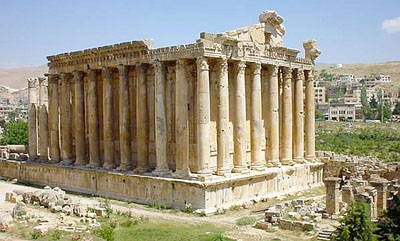
The complex includes the remaing temples, like for example, the Bacchus
Temple,
which is larger than the Acropolis in Athens.
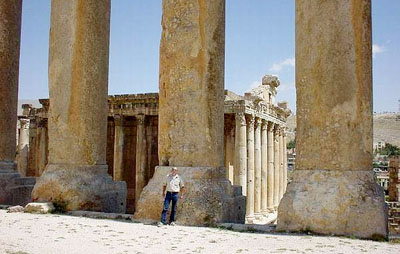
The remaining 6 pillars of the neighboring Jupiter Tempel
and its platform on which it was constructed, have exterior dimensions
as if they were built by people for "giants".
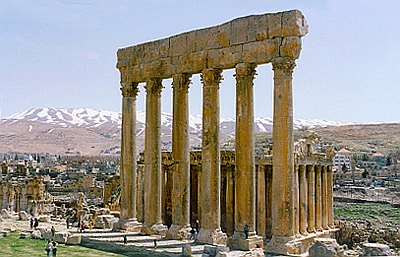
On some days these giants were on earth, and even later,
after the sons of the gods! mated with the daughters of men!
and these gave birth to children. These are the heroes of the eons,
the famous men.
(Genesis Chap. 6 Old Testament)
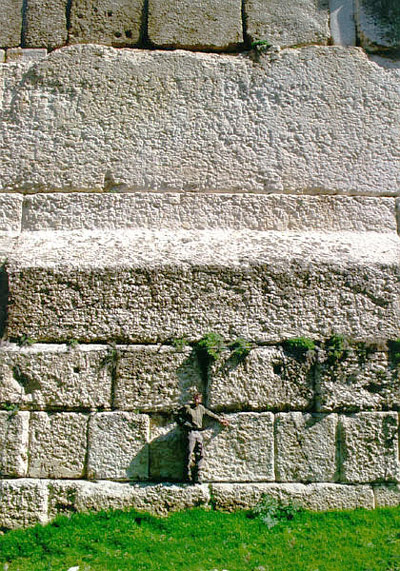
Here one recognizes the dimensions of the platform on which the Jupiter
Temple stood.
It is still not known how these stones were transported from the quarry
kilometers away and
built at this height. It is also unknown which technical tools and transport
equipment one used.
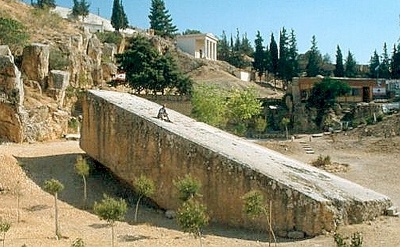
The largest stone (the largest building block of the world) is about
21.36m long,
4.33m high, 4.6m wide and weighs about 1200 and 2000 tons. It was transported
up the terrace
of Baalbek and has the name 'Hajar el Gouble' (Stone of the South) or
'Hajar el Hibla'
(Stone of the Pregnant Woman). This stone and the other cuboids of the
terrace of Baalback give the
archeologists and other scientists and engineers big mysteries. It is
unclear how such huge
stones were broken, transported and placed exactly in the foundations.
This also applies for the technical
possibilities in the ancient world as well as for today's modern methods.
Known displays from
Egypt and Mesopotamia show how stone blocks were transported by thousands
of workers with the help of
ropes and wooden rolls. But these stones only have a tenth of the mass
of the stones from Baalbek.
Moreover, the smaller stones were transproted over a flat route with
enough movement space.

The area in Baalbek rises upwards, cliffy and curvy, and offers
no space for manuveours. It also cannot be proven that the area was
once flattened in ancient times. Furthermore, the 1000 ton stones had
to be lifted and placed above each other in the foundations.
It is theoretically possible that ramps, scaffolding and pulleys were
used, supported from thousands
of men and draft animals. The construction of the Egyptian Obelisk in
front of St. Peter's Basilica in Rome
can be used as an example. The architect Domenico Fontana constructed
this 327 ton stone in the
Renaissance period with the help of 40 huge pulleys, 800 workers and
140 horses. However he had a
free and flat area. These advantages cannot be found in Baalbek. Even
if ramps were avaiable -
why are these not available nowadays? It seems clear that the terrace
of Baalbek is not from Roman times.
There are no Roman sources that mention the construction methods or
data and names of the patrons, engineers, architects and builders of
the terrace. The monolith of Trilithon (3 blocks each weighing
over 1000 tons, stacked with 6 blocks on the west side of the terrace)
do not display any ornaments
or structures that are similar to those of the Roman era. The limestone
blocks of the
Trilithon have strong traces of sand erosion suggesting an earlier construction
Ancient Arabic legends report:
"The stronghold on the mountain of Lebanon
is the oldest building of the world.
Cain, Adam's son, built it in the year 133 of creation in a fit of madness.
He gave it the name of his son Henoch and populated it with giants
who were punished with floods for their outrageousness.
After the flood, as Nimrod ruled over Lebanon, he let the giants come
to build the stronghold of Baalbek again, named in honor of Baal,
the god of the Moabites, who worshipped the sungod."
|